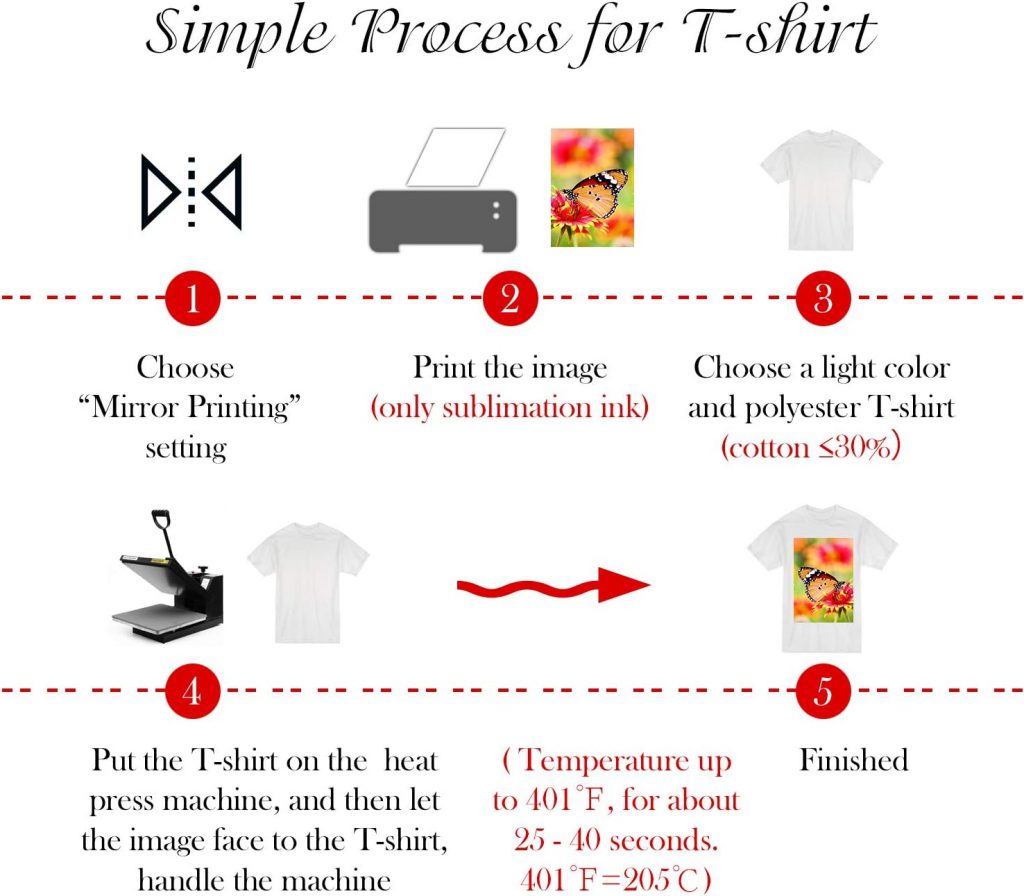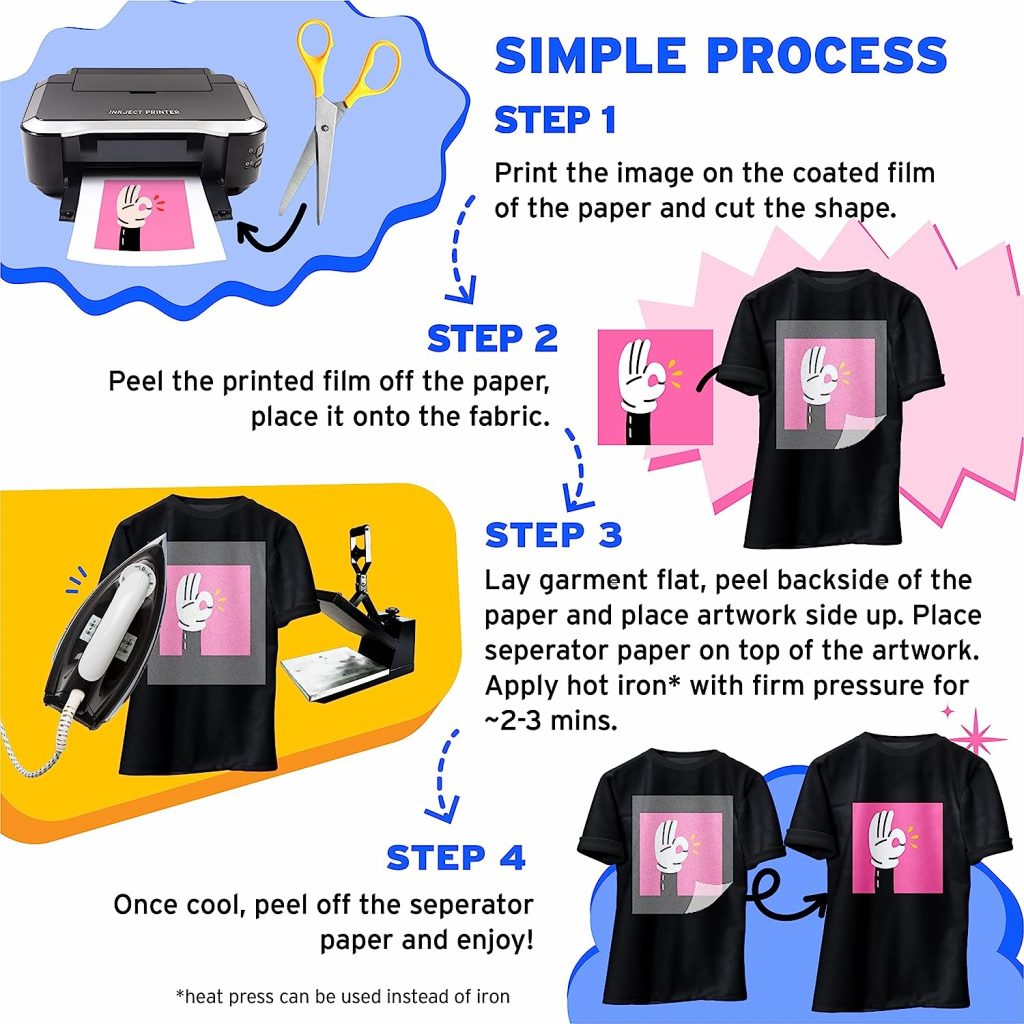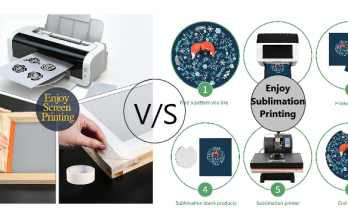Although they have differing prices and concerns, sublimation and heat transfer are two widely used techniques for printing pictures and patterns on a variety of materials. To assist you in making an educated decision for your projects, we’ll examine the costs associated with sublimation and heat transfer printing in this blog article.
Understanding Sublimation and Heat Transfer Printing
Before diving into the cost comparisons, let’s briefly revisit what sublimation and heat transfer printing involve.
Sublimation Printing: This method transfers a pattern from sublimation paper to a substrate, such cloth, mugs, or metal, by applying heat and pressure. It provides clear, strong pictures that don’t deteriorate or chip with time. When heated, sublimation ink transforms from a solid into a gas and then forms a bond with the substrate.
Heat Transfer Printing: In contrast, heat transfer printing involves applying ink to the material’s surface. When heat and pressure are applied, the ink sticks to the material’s surface to produce a contrasting coating of color.
Now, let’s explore the cost factors of these two methods.
Cost Considerations
Sublimation Printing Costs
Sublimation printing requires specific equipment and materials, including:
- Sublimation Printer: Depending on the brand and type, a sublimation printer can cost anywhere from $500 to $3000 as an initial investment. The printer’s size, features, and capabilities all affect this price.
- Sublimation Paper: To achieve seamless and reliable transfers, use premium sublimation paper. Although sublimation paper might be expensive, it’s still not too expensive when considering other parts.
- Sublimation Ink: This is an additional continuous cost. To guarantee the greatest results, high-quality ink is necessary. Although new ink bottles or cartridges usually cost less than $100 apiece, how frequently you change them depends on how much you print.
- Heat Press Machine: In order to transfer the design onto the substrate, a heat press machine is required. Although heat press machines come in a broad range of prices, a high-quality equipment can run you between $200 and $1,000.

Sublimation printing offers lower per-unit printing costs, especially for larger-scale production. Once the initial equipment is in place, the primary expenses are replacing ink and paper.
Heat Transfer Printing Costs
Heat transfer printing is more accessible in terms of initial costs. The required equipment and materials include:
- Inkjet Printer: Depending on the brand and features, an ordinary inkjet printer can cost anywhere from $50 to $300 when used for heat transfer printing.
- Heat Transfer Paper: For optimal results, use high-quality heat transfer paper. When weighed against other costs, heat transfer paper is not very expensive.
- Ink: Heat transfer printing may be done with standard inkjet ink, which is less expensive than sublimation ink. Usually, replacement ink bottles or cartridges cost less than $50 apiece.
- Heat Press Machine: Depending on the kind and features, a heat press machine can cost anywhere from $150 to $1,000. It is also necessary for heat transfer printing.

Sublimation printing offers long-lasting, vivid images that are embedded in the fabric. Heat transfer printing, on the other hand, can be more susceptible to wear and tear due to the ink remaining on the surface and potentially scratching or washing off over time. The cost differential between the two technologies may also be dependent on the quality and longevity of the prints.
Making the Right Choice
The decision between sublimation printing and heat transfer printing is contingent upon a variety of factors, such as budget, scale of the project, and desired print quality. While sublimation printing may incur a higher upfront cost due to the use of specialized equipment, it is more cost-effective in the long run due to its lower ongoing costs and improved print quality. Heat transfer printing, on the other hand, has lower initial costs and is more accessible, however, it is less cost-effective in larger quantities and may necessitate more frequent replacements of printed materials.
Ultimately, the decision should be based on the individual requirements of the project, the project size, and the desired quality expectations. Ultimately, the key to success is to create beautiful, durable designs that meet the customer’s needs.
Happy printing! 😊
Additional Resources:
- Mastering Sublimation Printing: Common Mistakes to Avoid – Discover how to avoid common mistakes in sublimation printing for flawless results.
- The Art of Sublimation Printing – Unleash your imagination and discover the transformative power of a sublimation printer.
- Difference between Sublimation and Heat Transfer – Explore the distinctions between sublimation and heat transfer methods for printing images or designs on various materials.
FAQs
Q1. Which printing method is more cost-effective for small-scale or hobbyist projects?
Ans: If you’re working on small-scale or hobbyist projects, heat transfer printing is usually more cost-effective. It requires less initial investment and is more accessible for occasional use.
Q2. Is sublimation printing more cost-effective for large-scale or commercial production?
Ans: Yes, sublimation printing tends to be more cost-effective for large-scale or commercial production. Once you have the necessary equipment, the per-unit printing costs are relatively low, making it an efficient choice for bulk orders.
Q3. Can I use a regular inkjet printer for heat transfer printing?
Ans: Yes, heat transfer printing can be done with a regular inkjet printer. To get the finest results, you must use the right heat transfer paper and ink, though.
Q4. Are there ongoing costs associated with both printing methods?
Ans: Sublimation and heat transfer printing do incur continuous expenses. Whereas heat transfer printing necessitates the purchase of ink and heat transfer paper, sublimation printing just requires replacement ink and paper.
Q5. Does the choice between sublimation and heat transfer printing affect the print quality?
Ans: Yes, print quality can be impacted by the technique of printing that is selected. Generally speaking, sublimation printing produces prints of greater quality that are durable, bright, and do not fade or break with time. Heat transfer prints could be more prone to damage.
Q6. Can I use sublimation ink with a standard inkjet printer?
Ans: No, sublimation ink is designed for use with specific sublimation printers. Using sublimation ink in a standard inkjet printer is not recommended, as it may damage the printer and yield subpar results.
Q7. Are there environmental considerations when choosing between the two methods?
Ans: Yes, there are environmental considerations. Sublimation printing is considered more environmentally friendly as it doesn’t involve water or generate waste. In contrast, heat transfer printing uses water and chemicals for cleanup, which can lead to ink and paper waste.





Thank you for engaging with the blog post, I hope you found the information valuable and gained insights. If you have any questions or if there’s anything specific you’d like to discuss further, feel free to let me know. Your feedback and interaction are appreciated. Stay tuned for more informative content!
Thank you so much for your incredibly kind words! I’m truly grateful for your appreciation and encouragement.